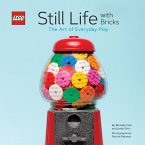Billy Ehn, Orvar Löfgren, Richard Wilk
Exploring Everyday Life
Strategies for Ethnography and Cultural Analysis
Billy Ehn, Orvar Löfgren, Richard Wilk
Exploring Everyday Life
Strategies for Ethnography and Cultural Analysis
- Gebundenes Buch
- Merkliste
- Auf die Merkliste
- Bewerten Bewerten
- Teilen
- Produkt teilen
- Produkterinnerung
- Produkterinnerung
Explores and explains how the mysteries of everyday life—from conversations and observations through web browsing and popular culture—can become the basis of rich ethnography and deep cultural analysis.
Andere Kunden interessierten sich auch für
![National Identity, Popular Culture and Everyday Life National Identity, Popular Culture and Everyday Life]() Tim EdensorNational Identity, Popular Culture and Everyday Life46,99 €
Tim EdensorNational Identity, Popular Culture and Everyday Life46,99 €![Ageing selves and everyday life in the north of England Ageing selves and everyday life in the north of England]() Cathrine DegnenAgeing selves and everyday life in the north of England110,99 €
Cathrine DegnenAgeing selves and everyday life in the north of England110,99 €![Everyday Post-Socialism Everyday Post-Socialism]() Jeremy MorrisEveryday Post-Socialism98,99 €
Jeremy MorrisEveryday Post-Socialism98,99 €![Everyday Life in Asia Everyday Life in Asia]() Devorah Kalekin-FishmanEveryday Life in Asia186,99 €
Devorah Kalekin-FishmanEveryday Life in Asia186,99 €![Caste in Everyday Life Caste in Everyday Life]() Caste in Everyday Life98,99 €
Caste in Everyday Life98,99 €![Sensing the Everyday Sensing the Everyday]() C. Nadia SeremetakisSensing the Everyday167,99 €
C. Nadia SeremetakisSensing the Everyday167,99 €![Lego Still Life with Bricks Lego Still Life with Bricks]() Lego Still Life with Bricks20,99 €
Lego Still Life with Bricks20,99 €-
-
-
Explores and explains how the mysteries of everyday life—from conversations and observations through web browsing and popular culture—can become the basis of rich ethnography and deep cultural analysis.
Produktdetails
- Produktdetails
- Verlag: Rowman & Littlefield Publishers
- Seitenzahl: 162
- Erscheinungstermin: 23. Juli 2015
- Englisch
- Abmessung: 235mm x 157mm x 14mm
- Gewicht: 395g
- ISBN-13: 9780759124059
- ISBN-10: 0759124051
- Artikelnr.: 42548379
- Herstellerkennzeichnung
- Libri GmbH
- Europaallee 1
- 36244 Bad Hersfeld
- gpsr@libri.de
- Verlag: Rowman & Littlefield Publishers
- Seitenzahl: 162
- Erscheinungstermin: 23. Juli 2015
- Englisch
- Abmessung: 235mm x 157mm x 14mm
- Gewicht: 395g
- ISBN-13: 9780759124059
- ISBN-10: 0759124051
- Artikelnr.: 42548379
- Herstellerkennzeichnung
- Libri GmbH
- Europaallee 1
- 36244 Bad Hersfeld
- gpsr@libri.de
Billy Ehn is professor emeritus of ethnology at Umeå University in Sweden. He is co-author, with Orvar Löfgren, of The Secret World of Doing Nothing.Orvar Löfgren is professor emeritus of ethnology at Lund University in Sweden. His publications include On Holiday: A History of Vacationing. Richard Wilk is Provost's Professor of Anthropology at Indiana University. His publications include Fast Food/Slow Food and Economies and Cultures (second edition, with Lisa Cliggett.) Richard Wilk and Orvar Löfgren, together with Jessica Chelakis, are co-editors of The Anthropology of Everyday Life, a Rowman & Littlefield series.
1-Hidden Worlds
Finding the tools
From idea to finished product
The need for a cultural perspective
Analytical strategies
Structure of the book
2-The importance of small things
The first step: getting going
The second step: searching for literature
The third step: collecting material
The fourth step: the analysis
The fifth step: writing
3-Making the familiar strange
Making a first attempt
Looking for entrances
To avoid the predictable
Choosing methodological entrances
New questions and surprising answers
Return to the past
A life-history perspective
The strange home
The home as an art installation
The importance of details and activities
The advantages of limitation
4-Sharing a meal
Table manners
The hidden world of the dinner table
Forming a family meal
Power at the table
Class and family history
Doing mealtime ethnography
Meals as models
5-Do you remember Facebook?
Exploring media in everyday life
Beginning at the end
Analog and digital living
Media taking place
Virtual intimacy
Are you there?
Follow the Objects
6-Catching a mood
Locating the setting
Analytical approaches
Touring the senses
The station as a sensorium
Changing moods
Describing atmospheres
Intimate moods
Changing tracks
Sensing the World
7-Crafting wood and words
Ethnographic writing
Making things with words
Autoethnographic writing
Describing non-verbal experience
Do it by feel
Writing DIY: three versions
Manual
Story
Analysis
Working knowledge
The importance of failures
Working and Writing
8-Demystifying fieldwork
The classic style
Making changes to the classic mold
The jungle ideal
Where is the field now?
Organizing information
Past, present, future
9-Taking cultural analysis out into the world
The surprise effect
Open fieldwork
What's this thing about culture?
A double cultural analysis
Learning to communicate
Time discipline and teamwork
Three ways of surprising a client
So what?
The critical edge
References
Finding the tools
From idea to finished product
The need for a cultural perspective
Analytical strategies
Structure of the book
2-The importance of small things
The first step: getting going
The second step: searching for literature
The third step: collecting material
The fourth step: the analysis
The fifth step: writing
3-Making the familiar strange
Making a first attempt
Looking for entrances
To avoid the predictable
Choosing methodological entrances
New questions and surprising answers
Return to the past
A life-history perspective
The strange home
The home as an art installation
The importance of details and activities
The advantages of limitation
4-Sharing a meal
Table manners
The hidden world of the dinner table
Forming a family meal
Power at the table
Class and family history
Doing mealtime ethnography
Meals as models
5-Do you remember Facebook?
Exploring media in everyday life
Beginning at the end
Analog and digital living
Media taking place
Virtual intimacy
Are you there?
Follow the Objects
6-Catching a mood
Locating the setting
Analytical approaches
Touring the senses
The station as a sensorium
Changing moods
Describing atmospheres
Intimate moods
Changing tracks
Sensing the World
7-Crafting wood and words
Ethnographic writing
Making things with words
Autoethnographic writing
Describing non-verbal experience
Do it by feel
Writing DIY: three versions
Manual
Story
Analysis
Working knowledge
The importance of failures
Working and Writing
8-Demystifying fieldwork
The classic style
Making changes to the classic mold
The jungle ideal
Where is the field now?
Organizing information
Past, present, future
9-Taking cultural analysis out into the world
The surprise effect
Open fieldwork
What's this thing about culture?
A double cultural analysis
Learning to communicate
Time discipline and teamwork
Three ways of surprising a client
So what?
The critical edge
References
1-Hidden Worlds
Finding the tools
From idea to finished product
The need for a cultural perspective
Analytical strategies
Structure of the book
2-The importance of small things
The first step: getting going
The second step: searching for literature
The third step: collecting material
The fourth step: the analysis
The fifth step: writing
3-Making the familiar strange
Making a first attempt
Looking for entrances
To avoid the predictable
Choosing methodological entrances
New questions and surprising answers
Return to the past
A life-history perspective
The strange home
The home as an art installation
The importance of details and activities
The advantages of limitation
4-Sharing a meal
Table manners
The hidden world of the dinner table
Forming a family meal
Power at the table
Class and family history
Doing mealtime ethnography
Meals as models
5-Do you remember Facebook?
Exploring media in everyday life
Beginning at the end
Analog and digital living
Media taking place
Virtual intimacy
Are you there?
Follow the Objects
6-Catching a mood
Locating the setting
Analytical approaches
Touring the senses
The station as a sensorium
Changing moods
Describing atmospheres
Intimate moods
Changing tracks
Sensing the World
7-Crafting wood and words
Ethnographic writing
Making things with words
Autoethnographic writing
Describing non-verbal experience
Do it by feel
Writing DIY: three versions
Manual
Story
Analysis
Working knowledge
The importance of failures
Working and Writing
8-Demystifying fieldwork
The classic style
Making changes to the classic mold
The jungle ideal
Where is the field now?
Organizing information
Past, present, future
9-Taking cultural analysis out into the world
The surprise effect
Open fieldwork
What's this thing about culture?
A double cultural analysis
Learning to communicate
Time discipline and teamwork
Three ways of surprising a client
So what?
The critical edge
References
Finding the tools
From idea to finished product
The need for a cultural perspective
Analytical strategies
Structure of the book
2-The importance of small things
The first step: getting going
The second step: searching for literature
The third step: collecting material
The fourth step: the analysis
The fifth step: writing
3-Making the familiar strange
Making a first attempt
Looking for entrances
To avoid the predictable
Choosing methodological entrances
New questions and surprising answers
Return to the past
A life-history perspective
The strange home
The home as an art installation
The importance of details and activities
The advantages of limitation
4-Sharing a meal
Table manners
The hidden world of the dinner table
Forming a family meal
Power at the table
Class and family history
Doing mealtime ethnography
Meals as models
5-Do you remember Facebook?
Exploring media in everyday life
Beginning at the end
Analog and digital living
Media taking place
Virtual intimacy
Are you there?
Follow the Objects
6-Catching a mood
Locating the setting
Analytical approaches
Touring the senses
The station as a sensorium
Changing moods
Describing atmospheres
Intimate moods
Changing tracks
Sensing the World
7-Crafting wood and words
Ethnographic writing
Making things with words
Autoethnographic writing
Describing non-verbal experience
Do it by feel
Writing DIY: three versions
Manual
Story
Analysis
Working knowledge
The importance of failures
Working and Writing
8-Demystifying fieldwork
The classic style
Making changes to the classic mold
The jungle ideal
Where is the field now?
Organizing information
Past, present, future
9-Taking cultural analysis out into the world
The surprise effect
Open fieldwork
What's this thing about culture?
A double cultural analysis
Learning to communicate
Time discipline and teamwork
Three ways of surprising a client
So what?
The critical edge
References









